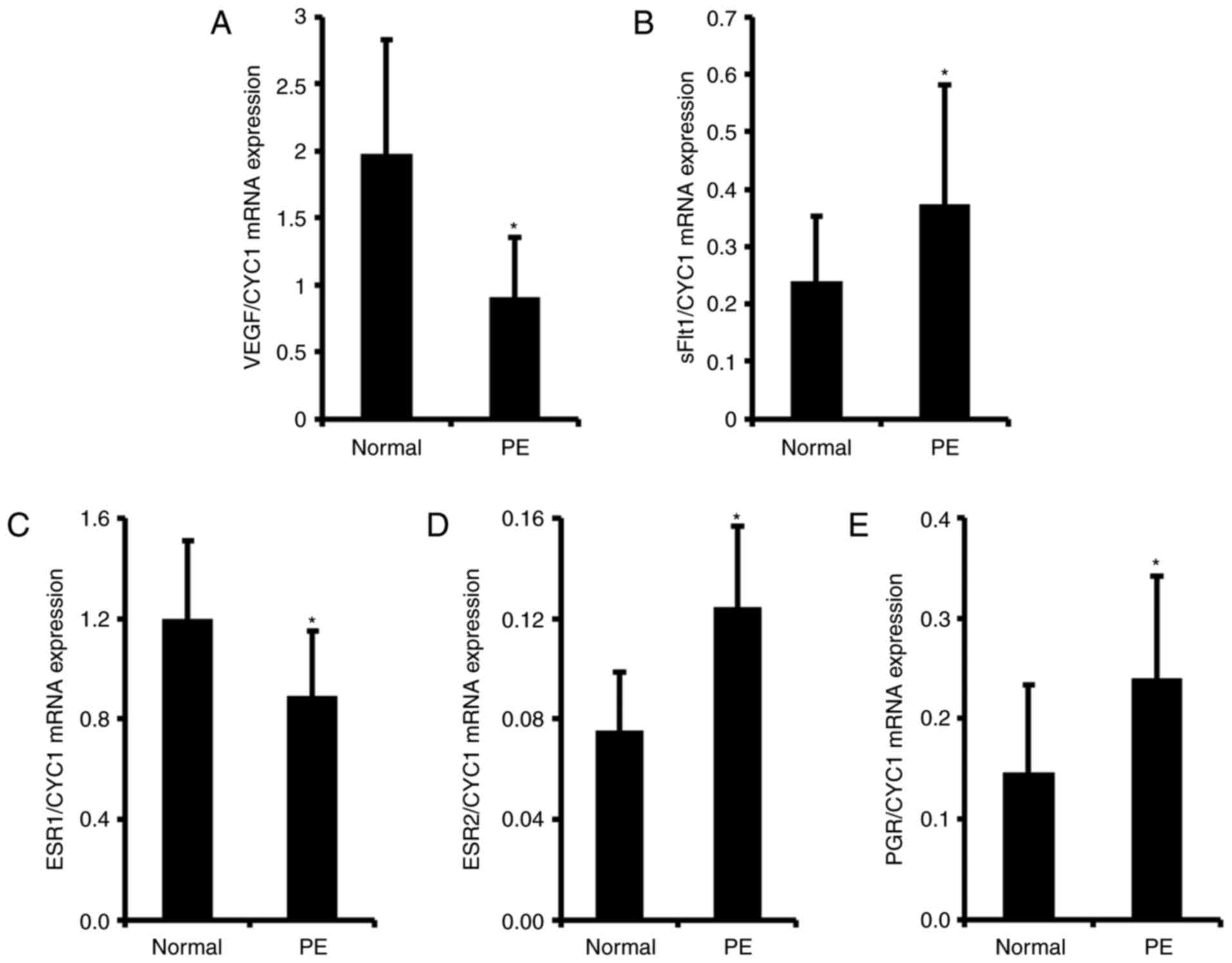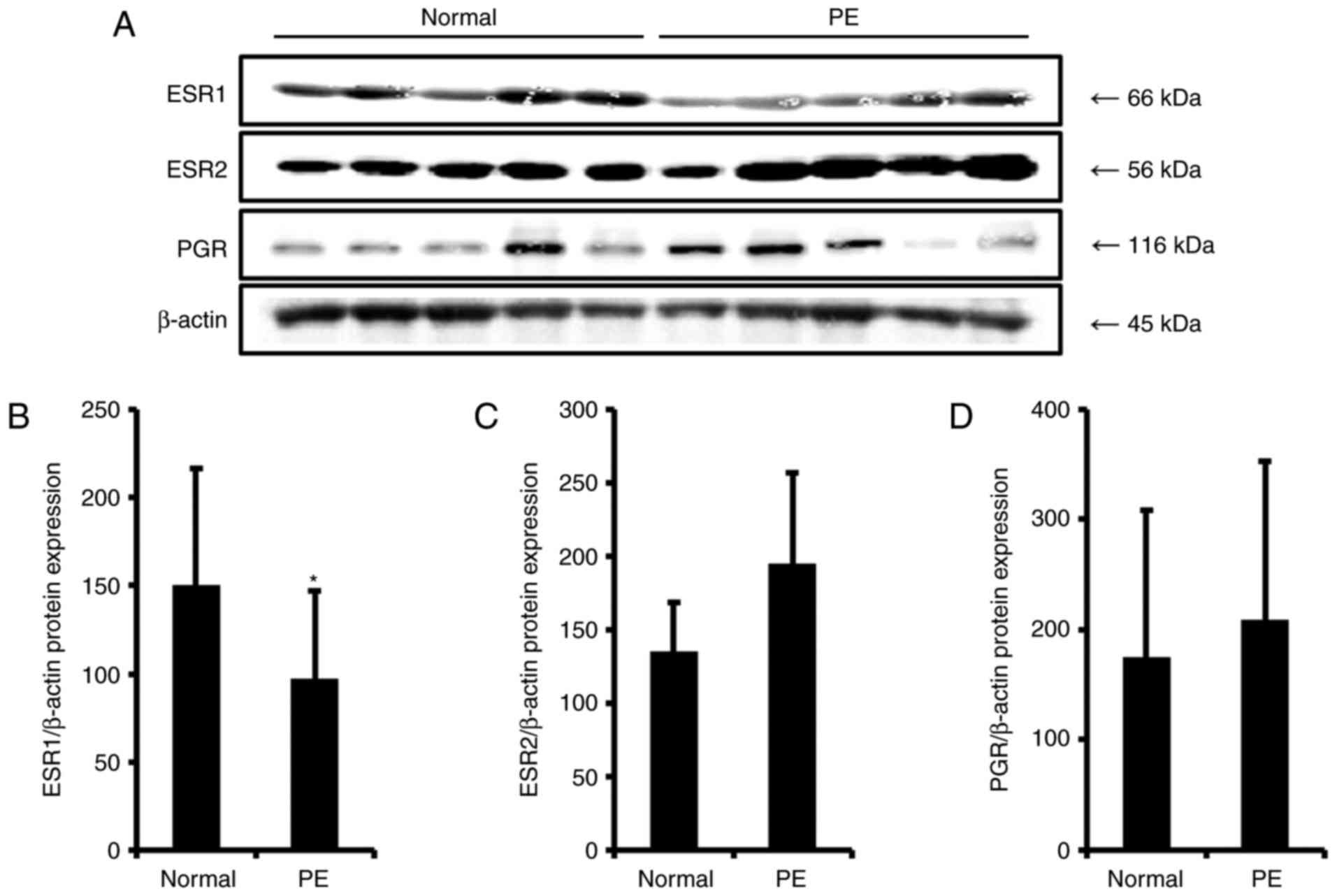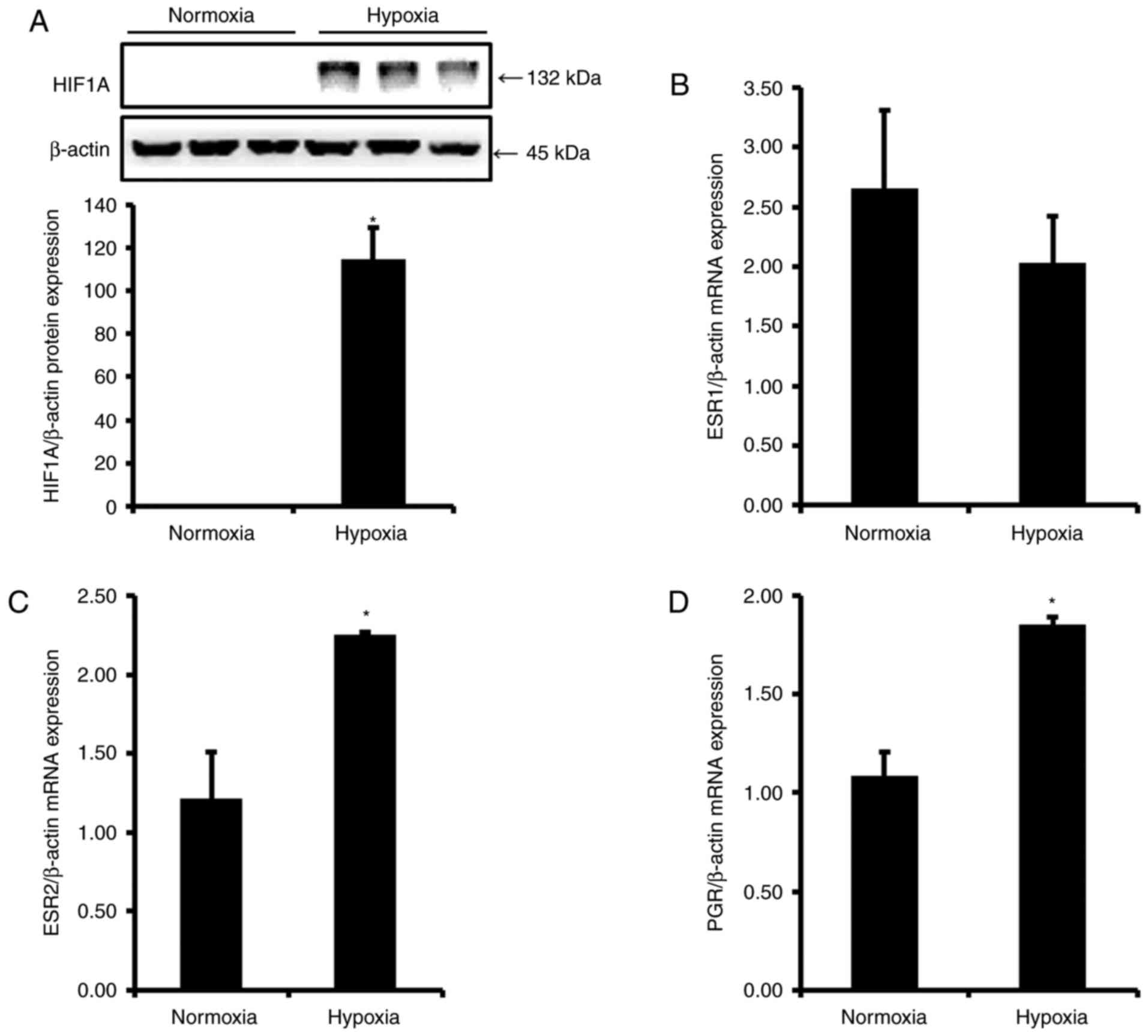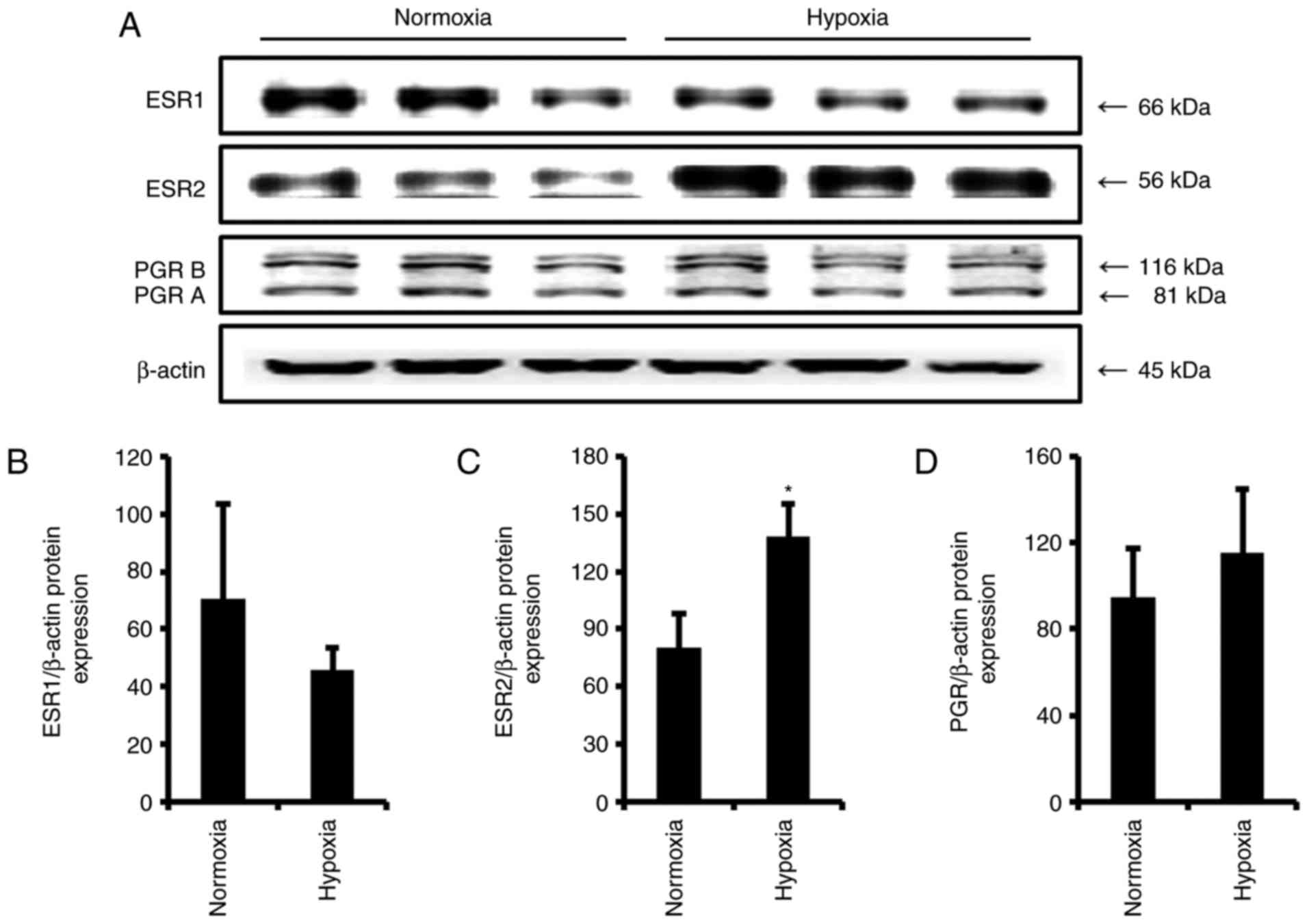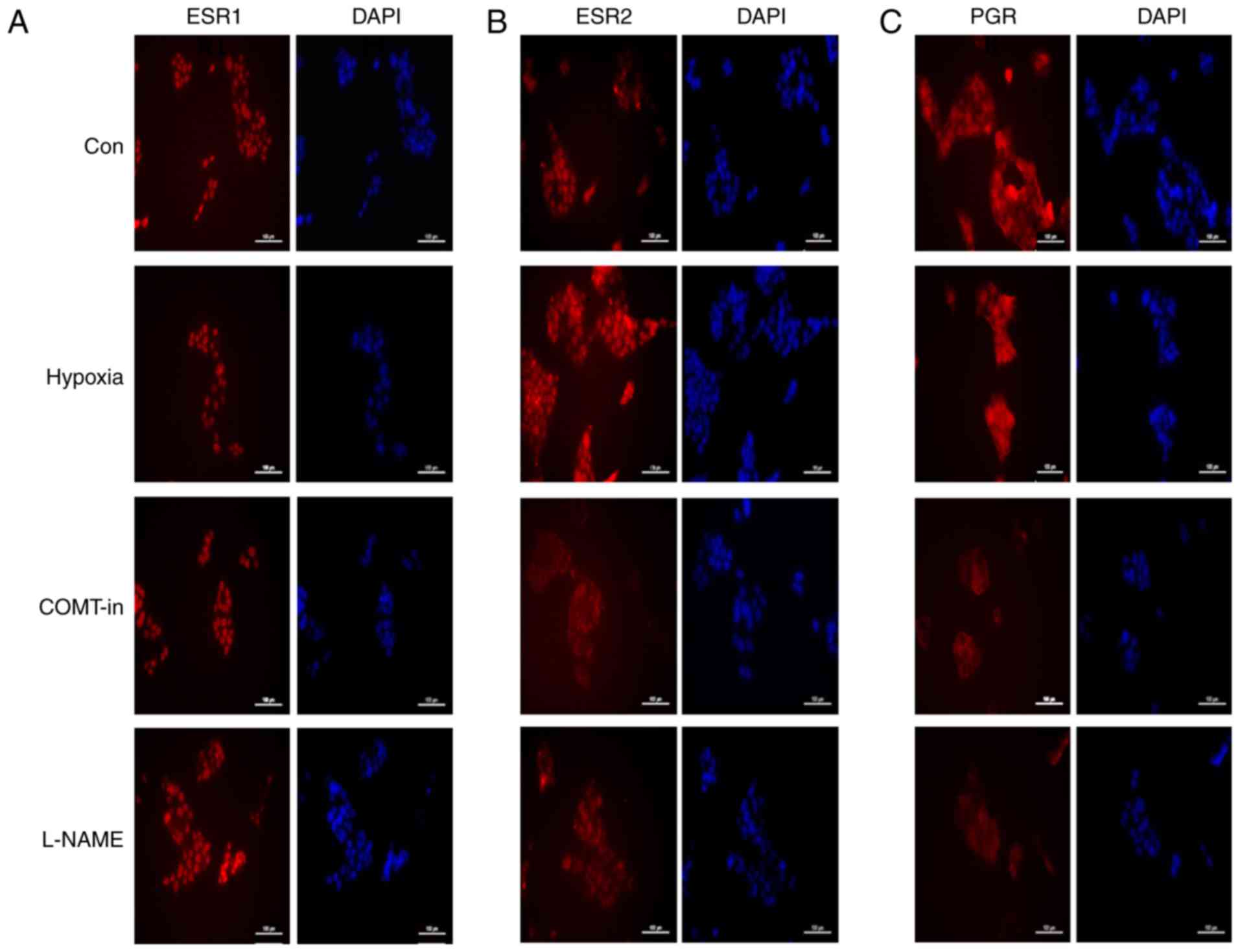|
1
|
Barker DJ: The fetal origins of coronary
heart disease. Acta Paediatr Suppl. 422:78–82. 1997. View Article : Google Scholar : PubMed/NCBI
|
|
2
|
Cockell AP and Poston L: Flow-mediated
vasodilatation is enhanced in normal pregnancy but reduced in
preeclampsia. Hypertension. 30:247–251. 1997. View Article : Google Scholar : PubMed/NCBI
|
|
3
|
Jobe SO, Tyler CT and Magness RR: Aberrant
synthesis, metabolism, and plasma accumulation of circulating
estrogens and estrogen metabolites in preeclampsia implications for
vascular dysfunction. Hypertension. 61:480–487. 2013. View Article : Google Scholar : PubMed/NCBI
|
|
4
|
Levine RJ, Maynard SE, Qian C, Lim KH,
England LJ, Yu KF, Schisterman EF, Thadhani R, Sachs BP, Epstein
FH, et al: Circulating angiogenic factors and the risk of
preeclampsia. N Engl J Med. 350:672–683. 2004. View Article : Google Scholar : PubMed/NCBI
|
|
5
|
VanWijk MJ, Kublickiene K, Boer K and
VanBavel E: Vascular function in preeclampsia. Cardiovasc Res.
47:38–48. 2000. View Article : Google Scholar : PubMed/NCBI
|
|
6
|
Furuya M, Kurasawa K, Nagahama K, Kawachi
K, Nozawa A, Takahashi T and Aoki I: Disrupted balance of
angiogenic and antiangiogenic signalings in preeclampsia. J
Pregnancy. 2011:1237172011. View Article : Google Scholar : PubMed/NCBI
|
|
7
|
Staun-Ram E and Shalev E: Human
trophoblast function during the implantation process. Reprod Biol
Endocrinol. 3:562005. View Article : Google Scholar : PubMed/NCBI
|
|
8
|
Pennington KA, Schlitt JM, Jackson DL,
Schulz LC and Schust DJ: Preeclampsia: Multiple approaches for a
multifacto-rial disease. Dis Model Mech. 5:9–18. 2012. View Article : Google Scholar : PubMed/NCBI
|
|
9
|
Genbacev O, Joslin R, Damsky CH, Polliotti
BM and Fisher SJ: Hypoxia alters early gestation human
cytotrophoblast differentiation/invasion in vitro and models the
placental defects that occur in preeclampsia. J Clin Invest.
97:540–550. 1996. View Article : Google Scholar : PubMed/NCBI
|
|
10
|
Dekker GA and Sibai BM: Low-dose aspirin
in the prevention of preeclampsia and fetal growth retardation:
Rationale, mechanisms, and clinical trials. Am J Obstet Gynecol.
168:214–227. 1993. View Article : Google Scholar : PubMed/NCBI
|
|
11
|
Altman D, Carroli G, Duley L, Farrell B,
Moodley J, Neilson J and Smith D; Magpie Trial Collaboration Group:
Do women with pre-eclampsia, and their babies, benefit from
magnesium sulphate? The Magpie Trial: A randomised
placebo-controlled trial. Lancet. 359:1877–1890. 2002. View Article : Google Scholar : PubMed/NCBI
|
|
12
|
Sibai B, Dekker G and Kupferminc M:
Pre-eclampsia. Lancet. 365:785–799. 2005. View Article : Google Scholar : PubMed/NCBI
|
|
13
|
Witlin AG and Sibai BM: Magnesium sulfate
therapy in preeclampsia and eclampsia. Obstet Gynecol. 92:883–889.
1998.PubMed/NCBI
|
|
14
|
Björnström L and Sjöberg M: Mechanisms of
estrogen receptor signaling: Convergence of genomic and nongenomic
actions on target genes. Mol Endocrinol. 19:833–842. 2005.
View Article : Google Scholar : PubMed/NCBI
|
|
15
|
Chen JZ, Sheehan PM, Brennecke SP and
Keogh RJ: Vessel remodelling, pregnancy hormones and extravillous
trophoblast function. Mol Cell Endocrinol. 349:138–144. 2012.
View Article : Google Scholar
|
|
16
|
Açıkgöz Ş, Bayar UO, Can M, Güven B,
Mungan G, Doğan S and Sümbüloğlu V: Levels of oxidized LDL,
estrogens, and progesterone in placenta tissues and serum
paraoxonase activity in preeclampsia. Mediators Inflamm.
2013:8629822013. View Article : Google Scholar
|
|
17
|
Feng Y, Zhang P, Zhang Z, Shi J, Jiao Z
and Shao B: Endocrine disrupting effects of triclosan on the
placenta in pregnant rats. PLoS One. 11:e01547582016. View Article : Google Scholar : PubMed/NCBI
|
|
18
|
Albrecht ED and Pepe GJ: Estrogen
regulation of placental angiogenesis and fetal ovarian development
during primate pregnancy. Int J Dev Biol. 54:397–408. 2010.
View Article : Google Scholar :
|
|
19
|
Magness RR: Maternal cardiovascular and
other physiologic responses to the endocrinology of pregnancy.
Endocrinol Pregnancy. 9:507–539. 1998. View Article : Google Scholar
|
|
20
|
Magness RR and Rosenfeld CR: Local and
systemic estradiol-17 beta: Effects on uterine and systemic
vasodilation. Am J Physiol. 256:E536–E542. 1989.PubMed/NCBI
|
|
21
|
Reynolds LP, Kirsch JD, Kraft KC, Knutson
DL, McClaflin WJ and Redmer DA: Time-course of the uterine response
to estradiol-17beta in ovariectomized ewes: Uterine growth and
microvascular development. Biol Reprod. 59:606–612. 1998.
View Article : Google Scholar : PubMed/NCBI
|
|
22
|
Szekeres-Bartho J: Immunosuppression by
progesterone in pregnancy. CRC Press; pp. 1–155. 1992
|
|
23
|
Buhimschi I, Yallampalli C, Chwalisz K and
Garfield RE: Pre-eclampsia-like conditions produced by nitric oxide
inhibition: Effects of L-arginine, D-arginine and steroid hormones.
Hum Reprod. 10:2723–2730. 1995. View Article : Google Scholar : PubMed/NCBI
|
|
24
|
Ito M, Nakamura T, Yoshimura T, Koyama H
and Okamura H: The blood pressure response to infusions of
angiotensin II during normal pregnancy: Relation to plasma
angiotensin II concentration, serum progesterone level, and mean
platelet volume. Am J Obstet Gynecol. 166:1249–1253. 1992.
View Article : Google Scholar : PubMed/NCBI
|
|
25
|
Liao QP, Buhimschi IA, Saade G, Chwalisz K
and Garfield RE: Regulation of vascular adaptation during pregnancy
and post-partum: Effects of nitric oxide inhibition and steroid
hormones. Hum Reprod. 11:2777–2784. 1996. View Article : Google Scholar : PubMed/NCBI
|
|
26
|
Radwanska E: The role of reproductive
hormones in vascular disease and hypertension. Steroids.
58:605–610. 1993. View Article : Google Scholar : PubMed/NCBI
|
|
27
|
Dodd JM, Jones L, Flenady V, Cincotta R
and Crowther CA: Prenatal administration of progesterone for
preventing preterm birth in women considered to be at risk of
preterm birth. Cochrane Database Syst Rev. CD0049472013.PubMed/NCBI
|
|
28
|
Hass DM and Ramsey PS: Progestogen for
preventing miscarriage. Cochrane Database Syst Rev.
CD0035112008.
|
|
29
|
Meher S and Duley L: Interventions for
preventing pre-eclampsia and its consequences: Generic protocol.
Cochrane Libr. CD0053012005.
|
|
30
|
Jones HN, Ashworth CJ, Page KR and McArdle
HJ: Cortisol stimulates system A amino acid transport and SNAT2
expression in a human placental cell line (BeWo). Am J Physiol
Endocrinol Metab. 291:E596–E603. 2006. View Article : Google Scholar : PubMed/NCBI
|
|
31
|
Livak KJ and Schmittgen TD: Analysis of
relative gene expression data using real-time quantitative PCR and
the 2(−Delta Delta C(T)) method. Methods. 25:402–408. 2001.
View Article : Google Scholar
|
|
32
|
Carty DM, Delles C and Dominiczak AF:
Novel biomarkers for predicting preeclampsia. Trends Cardiovasc
Med. 18:186–194. 2008. View Article : Google Scholar : PubMed/NCBI
|
|
33
|
Hiratsuka S, Maru Y, Okada A, Seiki M,
Noda T and Shibuya M: Involvement of Flt-1 tyrosine kinase
(vascular endothelial growth factor receptor-1) in pathological
angiogenesis. Cancer Res. 61:1207–1213. 2001.PubMed/NCBI
|
|
34
|
Ahmed A, Dunk C, Ahmad S and Khaliq A:
Regulation of placental vascular endothelial growth factor (VEGF)
and placenta growth factor (PlGF) and soluble Flt-1 by oxygen-a
review. Placenta. 21(Suppl A): S16–S24. 2000. View Article : Google Scholar
|
|
35
|
McKeeman GC, Ardill JE, Caldwell CM,
Hunter AJ and McClure N: Soluble vascular endothelial growth factor
receptor-1 (sFlt-1) is increased throughout gestation in patients
who have preeclampsia develop. Am J Obstet Gynecol. 191:1240–1246.
2004. View Article : Google Scholar : PubMed/NCBI
|
|
36
|
Yin G, Zhu X, Guo C, Yang Y, Han T, Chen
L, Yin W, Gao P, Zhang H, Geng J, et al: Differential expression of
estradiol and estrogen receptor α in severe preeclamptic
pregnancies compared with normal pregnancies. Mol Med Rep.
7:981–985. 2013. View Article : Google Scholar : PubMed/NCBI
|
|
37
|
Schiessl B, Mylonas I, Hantschmann P, Kuhn
C, Schulze S, Kunze S, Friese F and Jeschke U: Expression of
endothelial NO synthase, inducible NO synthase, and estrogen
receptors alpha and beta in placental tissue of normal,
preeclamptic, and intrauterine growth-restricted pregnancies. J
Histochem Cytochem. 53:1441–1449. 2005. View Article : Google Scholar : PubMed/NCBI
|
|
38
|
Manoranjan B, Salehi F, Scheithauer BW,
Rotondo F, Kovacs K and Cusimano MD: Estrogen receptors alpha and
beta immunohistochemical expression: Clinicopathological
correlations in pituitary adenomas. Anticancer Res. 30:2897–2904.
2010.PubMed/NCBI
|
|
39
|
Nevo O, Soleymanlou N, Wu Y, Xu J, Many A,
Zamudio S and Caniggia I: Increased expression of sFlt-1 in in vivo
and in vitro models of human placental hypoxia is mediated by
HIF-1. Am J Physiol Regul Integr Comp Physiol. 291:R1085–R1093.
2006. View Article : Google Scholar : PubMed/NCBI
|
|
40
|
Soleymanlou N, Jurisica I, Nevo O, Ietta
F, Zhang X, Zamudio S, Post M and Caniggia I: Molecular evidence of
placental hypoxia in preeclampsia. J Clin Endocrinol Metab.
90:4299–4308. 2005. View Article : Google Scholar : PubMed/NCBI
|
|
41
|
Babbedge RC, Bland-Ward PA, Hart SL and
Moore PK: Inhibition of rat cerebellar nitric oxide synthase by
7-nitro indazole and related substituted indazoles. Br J Pharmacol.
110:225–228. 1993. View Article : Google Scholar : PubMed/NCBI
|
|
42
|
Pertegal M, Fenoy FJ, Hernández M,
Mendiola J, Delgado JL, Bonacasa B, Corno A, López B, Bosch V and
Hernández I: Fetal Val108/158Met catechol-O-methyltransferase
(COMT) polymorphism and placental COMT activity are associated with
the development of preeclampsia. Fertil Steril. 105:134–143. e1–e3.
2016. View Article : Google Scholar
|
|
43
|
Kanasaki K, Palmasten K, Sugimoto H, Ahmad
S, Hamano Y, Xie L, Parry S, Augustin SH, Gattone VH, Folkman J, et
al: Deficiency in catechol-O-methyltransferase and
2-methoxyoestradiol is associated with pre-eclampsia. Nature.
453:1117–1121. 2008. View Article : Google Scholar : PubMed/NCBI
|
|
44
|
Yallampalli C and Garfield RE: Inhibition
of nitric oxide synthesis in rats during pregnancy produces signs
similar to those of preeclampsia. Am J Obstet Gynecol.
169:1316–1320. 1993. View Article : Google Scholar : PubMed/NCBI
|
|
45
|
Beato M: Gene regulation by steroid
hormones. Cell. 56:335–344. 1989. View Article : Google Scholar : PubMed/NCBI
|



